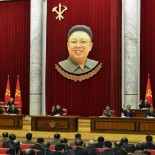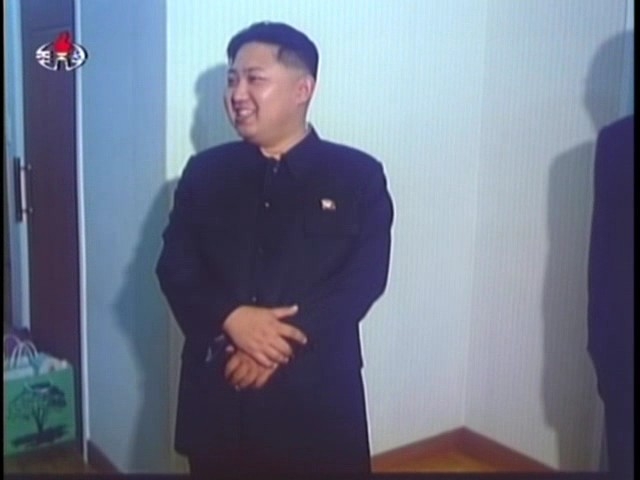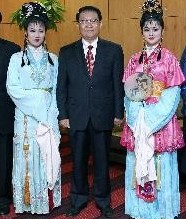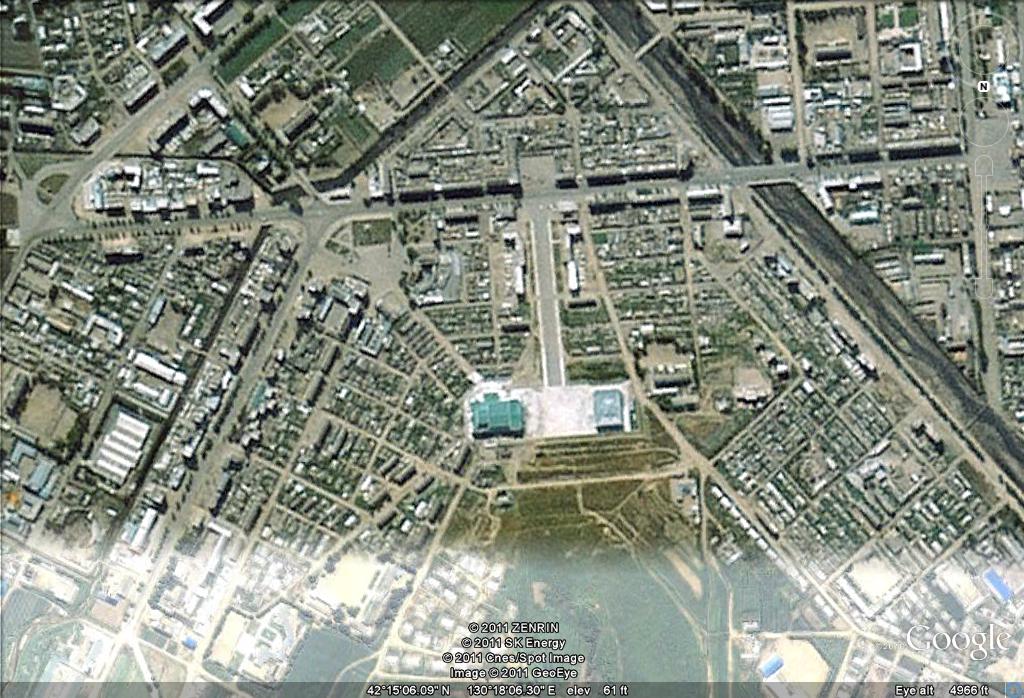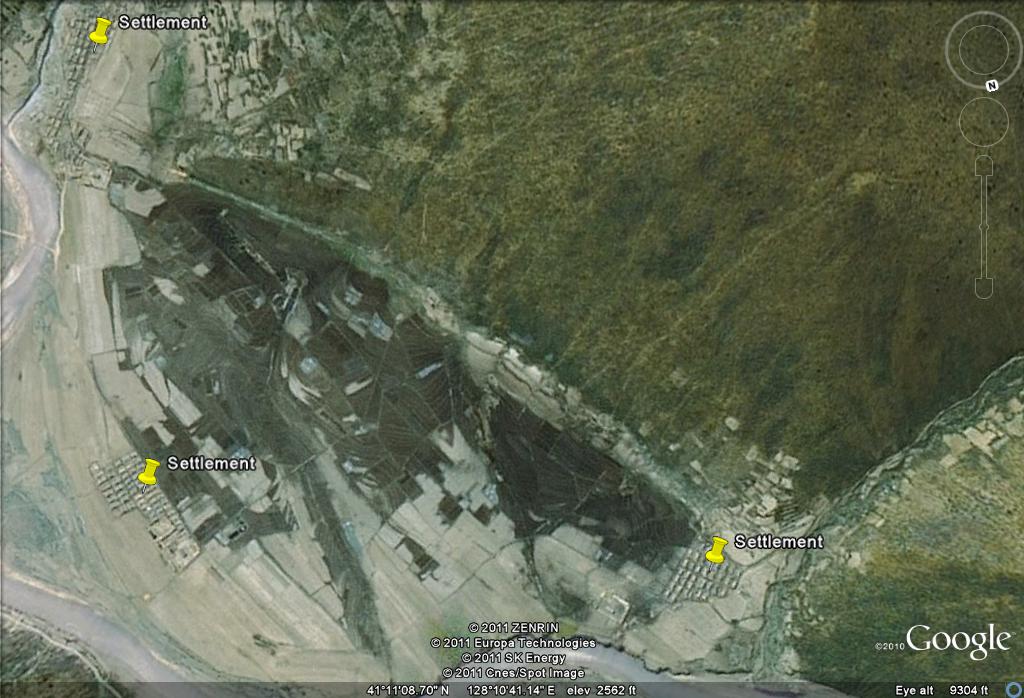Jong Un Trial Balloon to Beijing (Or a stalking horse to Jilin?)
2010 was the year Pyongyang watchers waited for Kim Cho’ng-il to travel to China. KCI managed to live up to the hype, as news photographers staked out his private train. When the media veil under which he traveled blew off in May 2010, he strolled around service entrances and hotel lobbies. His second trip to northeastern Chinese provinces during August 2010 had the surprise element of other trips and was more of a controlled affair, despite the parking lot handshake photo and rumors of Kim Cho’ng-u’n reciting poetry.
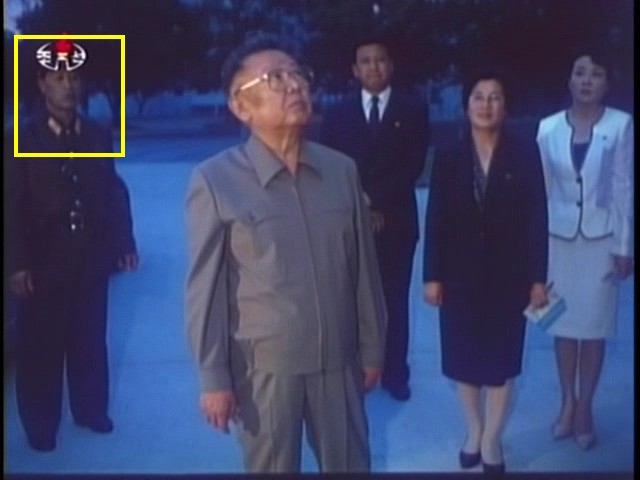
A member of the personal security escort in the Guard Command, preparing for Kim Cho'ng-il's departure October 2010 (Photo: KCNA)
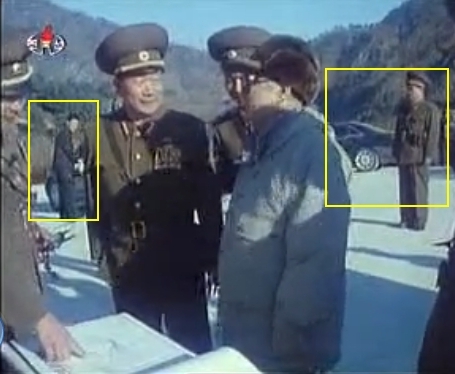
Members of the Guard Commands and vehicles from Kim Chong-il's motorcade are highted in this image from KCI's November 2010 visit to the Huichon Power Station in Chagang Province
2011 has become the year to inflate the trial balloon of Kim Cho’ng-u’n visiting China. Several anticipated dates of his departure and arrival have come and gone. However, JoongAng Ilbo reports on the possibility that a delegation of the Guard Command recently visited the PRC:
The activity comes amid rumors that North Korea‟s heir apparent Kim Jong-un would visit China sometime this month.
“I heard that 20 or so North Korean secret agents arrived in Beijing,” a source said, adding they traveled in vehicles with black tinted windows that were escorted by Chinese security.
“They appear to have come on a special mission, nothing to do with regular exchanges between the parties and the governments [between North Korea and China],” the source said.
The source said the special agents were presumed to belong to the North‟s equivalent of the U.S. Secret Service and to be in charge of security for high-profile figures in the North.
Customarily, such advance trips by security have been followed within a week by a visit from a top-ranking official.
Air Koryo, the North Korea‟s official airline, shuttles between Pyongyang and Beijing on Tuesdays and Thursdays. The source said the North Korean agents could have come to Beijing on a specially arranged flight, or via other means.
“There is possibility that they will stay in Beijing for three or four days before moving to three provinces in Northeast China, including Dandong, on the border with North Korea,” the source said.
If the preparations are for a visit by Kim Jong-un, it would be his first solo trip to the North‟s staunchest ally, an event that would be compared to the China visit made by his father in 1983. Kim Jong-il, then the heir apparent to North Korean founder Kim Il Sung, traveled to China for the first time without his father that year.
Such a solo trip to China is used to bolster the legitimacy of an heir apparent, even more important now than in the 1980s with China‟s increasing global influence and the untested loyalty of North Korea‟s masses to Kim Jong-un.
Kim Jong-un is believed to have turned 28 or 29 in January.
The source did not exclude the possibility that the trip could be for a different high-ranking official.
But another North Korean source in Beijing said that if the agents were indeed members of the North‟s Secret Service equivalent, they would be preparing for a trip by either Kim Jong-un or Kim Jong-il.
A third source in Beijing said if Kim Jong-il or Kim Jong-un were coming, members of North Korea‟s top secretary service, in charge of personal services for Kim Jong-il, would be on the advance team. It wasn‟t clear whether they were or not.
DPRK media reported on a meeting between the next PRC leader, Xi Jinping, and DPRK Ambassador to the PRC Chi Chae-yong [Ji Jae Ryong], which was interpreted as another preparatory function in advance of Kim Cho’ng-u’n visiting the PRC. KCNA reported on the meeting:
He noted that leader Kim Jong Il visited China twice last year to meet with President Hu Jintao and reach an agreement of views on the bilateral relations and major issues of common concern. This year the leader received Meng Jianzhu, state councilor of China, on a visit to the DPRK and enjoyed together with officials of the Chinese embassy in Pyongyang a concert given by the Unhasu Orchestra on the 15th of January under the lunar calendar, he added.
It is the fixed strategic policy of the Chinese party and government to steadily develop the China-DPRK relations of neighborly friendship and cooperation, Xi said.
He hoped that the bilateral relations would further develop by maintaining exchange of high-level visits, deepening understanding of each other’s strategic view and strengthening economic cooperation.
One of the events (perhaps unrelated) interpreted as an indication that KCI would visit the PRC in May 2010 was the public departure of the P’ibada Opera Troupe for a performance run of A Dream of Red Mansions. The P’ibada troupe’s arrival ended up preceding KCI’s and he was expected during his trip to Beijing to attend a performance. On 2 May 2011 the Pyongyang Art Troupe departed the country (via Pyongyang Railway Station) for a three-month concert tour organized by a PRC promoter. The Pyongyang Art Troupe is composite cultural organization of dancers, singers and musicians drawn from three of the countries elite performance groups. The troupe will travel throughout PRC and perform at several music and art festivals; given the troupe’s performance schedule, one might put Cho’ng-u’n’s visit during the May through July tour.
The presence of security officials and performing groups may portend a visit from one of the Kims, or the security officials could be planning for a significant DPRK-PRC event in the Naso’n area. Hankyoreh reports about an event scheduled in that area in late May:
A number of sources, including officials with the Jilin Province government in China, reported that a groundbreaking ceremony is to be held on May 30 for a highway linking the North Korea cities of Wonjong and Naso’n, bordering directly on Quanhe in Hunchun, Jilin Province. A number of leaders from both countries are scheduled to attend the ceremony, which is to take place in Naso’n (Rajin-Sonbong), North Korea.
A Chinese official working on preparations for the project said in a recent interview with the Hankyoreh that the event would be “an occasion for declaring North Korea-China economic cooperation and North Korean openness to the world.” The official added that dozens of officials from the Chinese central government would be attending, including a number of leaders.
The construction effort is a signal announcing the opening of Naso’n and large-scale economic cooperation between North Korea and China. In addition to the groundbreaking ceremony for the highway, which is to be a major channel tying North Korea and China together economically, efforts to develop China’s Rajin Harbor and transport large amounts of coal through it are beginning in earnest.
The Naso’n development effort is taking place according to China’s “blueprints” in everything from the planning to investment and management. Local sources said that China and North Korea have already formed a special joint steering committee for the district, and that it has been decided that the chairman will be from China.
The Naso’n urban development plan jointly drafted by China and North Korea includes the development of international freight brokerage, export processing, and financial regions. According to a North Korean video, models for the plan include Dalian and Tianjin, which Kim Jong Il inspected in 2010 during a visit to China.
An official with the Yanji city government said, “North Korea is also aware that keeping its doors closed will only lead to death, but it is concerned that the regime will be destabilized if it opens up all at once, so it plans to first open up Rajin and develop it as a ‘test region.'”
“They are adopting the Chinese model, learning from China about legislation, taxes, and benefits to lure businesses,” the official added.
The effort is being pursued promptly, in contrast with previous North Korea-China economic efforts, which tended to amount to little more than words.
The reason for this is that the central governments in Beijing and Pyonyang are directly taking care of economic cooperation through the medium of Naso’n’s development.
News (or rumor) of a large DPRK-PRC event centered around Naso’n comes as RFA reports of increasing mineral exports to China:
According to Radio Free Asia (RFA), the communist state’s exports of mineral resources reached US$860 million last year, compared with some $50 million in 2002.
Citing data compiled by the Korea Trade-Investment Promotion Agency, the RFA said exports of such minerals as coal and iron ore accounted for 63 percent of its total exports to its strongest ally China.
In the first quarter of the year, the North earned around $154 million by exporting coal to the neighboring country, compared with $9.68 million seen a year earlier.
North Korea’s mineral reserves are believed to be among the largest in the world, worth some 7,000 trillion won, based on 2008 prices, according to an earlier report by the Unification Ministry.
Ports, processing factories and new roads do not seem to be the only economic activity occurring in Naso’n. The DPRK has indicted two Japanese citizens on charges of narcotics trafficking and counterfeiting. On or around 14 March 2011, the DPRK arrested three Japanese men after they entered the DPRK through a road into Naso’n. According to Kyodo, they were taken to Pyongyang. Masaki Furuya, who is in his 70s and the oldest of the three men, was expelled from the country to the PRC prior to his return to Japan. According to KCNA:
Masaki Furuya, former representative managing director of JP Dairin Co. Ltd., Hidehiko Abe, representative managing director of Realise Co. Ltd, of Japan, and Takumi Hirooka, managing director of Sugita Industrial Co. Ltd, of Japan, were put in custody by a relevant body on charges of drug trafficking and counterfeit after entering Naso’n City of the DPRK on March 14.
They admitted their crimes and their gravity.
Masaki Furuya had already been expelled from the DPRK and the two Japanese are called to legal accounts.
What they did is a very grave violation of the law of the DPRK and international law and they will, therefore, face proper legal actions.
It is not clear what the men were doing near Naso’n, but one would expect the country’s authorities to ensure Office #39’s monopoly over the kinds of activities of which the DPRK has accused Mr. Abe and Mr. Hirooka. With the succession candidacy of Kim Cho’ng-u’n underscored by his management role in the Ministry of State Security, the regime intensified surveillance and enforcement on DPRK citizens for a number of border-related infractions. ROK-based defector media have claimed that Cho’ng-u’n has played an instrumental role in the crackdown on migrants, traders and their families, including the designation of isolated control zones in Yaggang Province where families are being sent. One may wish to contrast Cho’ng-u’n reputation in treating migrant families with that of Kim Cho’ng-nam; in the 1990s the security services exercised leniency with these families, credited to Cho’ng-nam.
Yonhap reported:
“I understand Kim Jong-un is involved in security affairs in the method of directly receiving reports and handing down instructions though he does not have any formal titles of related offices,” a source told Yonhap News Agency. “He is especially showing a lot of attention to the issue of defectors.”
Kim is also thought to be behind Pyongyang’s persistent demand for the return of four North Korean residents who sought asylum in South Korea after their fishing boat drifted across the tense western sea border into the South in February.The four were part of a larger group of 31 North Koreans. Seoul sent 27 of them back to their homeland in March, but the other four remained after they expressed their desire to defect. The North has since called for their repatriation, a demand that Seoul has spurned.
Kim allegedly instructed related government offices to bring the four people home by all means in order to prevent similar recurrences.
The heir-apparent’s strong commitment to resolving the incident pushed the North’s public security agencies to produce a tangible result in dealing with the matter, according to the sources.
Some speculate that the intensified crackdown is driven as part of Pyongyang’s efforts to strengthen Kim’s role in its power hierarchy.
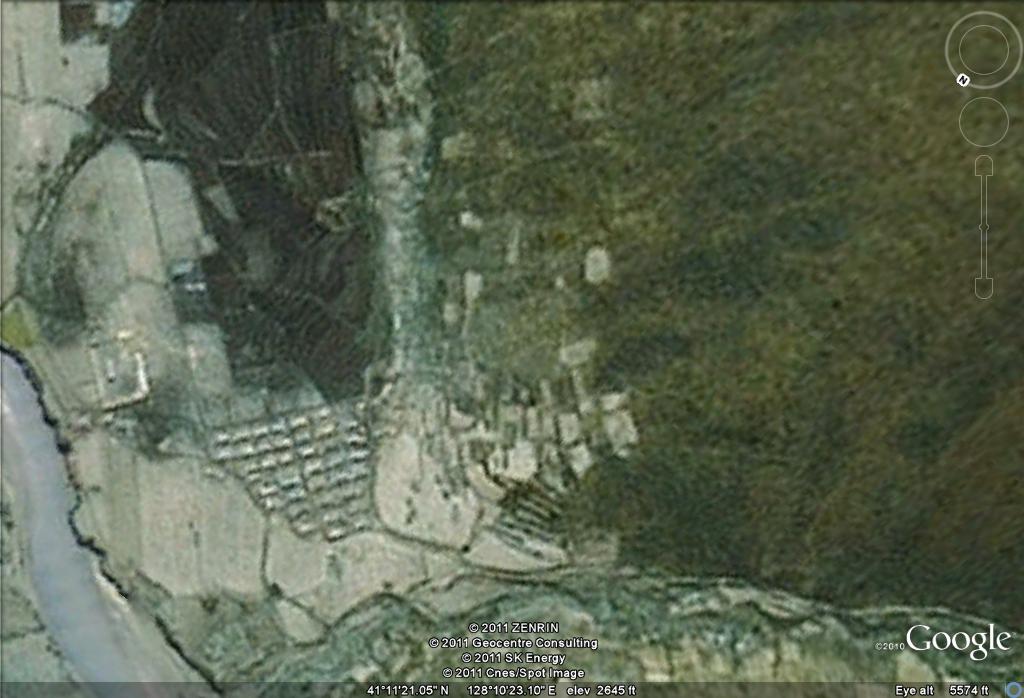
According to reports in ROK-based defector media outlet Daily NK, Cho'sun-ri, Yanggang Province, is one area designated for DPRK families expelled to the countryside due to unauthorized communication with or migration to ROK. (Photo: Google image)
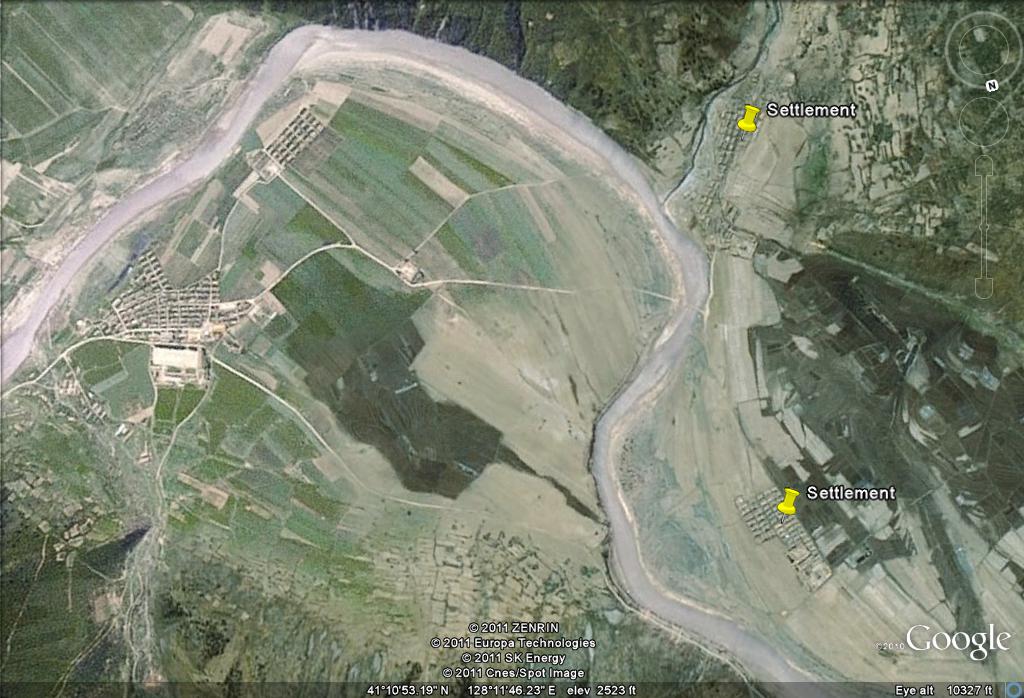
Settlements in Yanggang Province which may be designated for DPRK citizens and families banished to the countryside. One can note the nearest community (left in the image) is approximately 1 mile (1.6 km) west and across a river (Photo: Google image)
